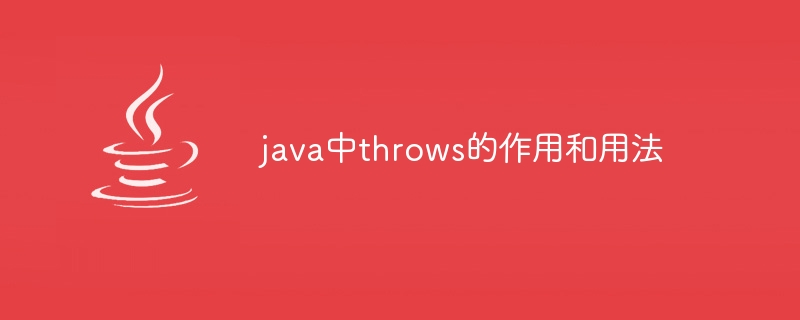The role and usage of throws in java
Thethrows keyword is used to handle exceptions, allowing methods to delegate exceptions to the caller without handling. It identifies the types of exceptions that a method may throw and allows methods to throw exceptions in the method body and delegate exception handling upwards.

The role and usage of throws in Java
The throws keyword is used to handle exceptions in Java, allowing methods Delegate the exception to the method that calls it. This means that the delegated method does not have to handle the exception it catches, but can throw the exception up to be handled by higher-level code.
Function
- Identifies the types of exceptions that may be thrown by a method
- Allows a method to delegate an exception to the method that calls it instead of handling it It
Usage
#1. Declare exceptions in method declaration
public void doSomething() throws IOException, SQLException {
// 方法体
}Use throws in method declaration The keyword followed by the exception type indicates that the method may throw these types of exceptions. The code calling the method must handle these exceptions or delegate them further.
2. Throw an exception in the method body
try {
// 执行一些操作
} catch (IOException | SQLException e) {
throw e;
}In the method body, you can throw an exception by using the throw keyword followed by the exception object. This will cause the exception to be delegated to the code that calls the method.
Advantages
- ##Better exception handling: throws improves performance by allowing methods to clearly identify exceptions that may occur based on their logic Improved exception handling clarity.
- More flexible exception delegation: Instead of explicitly rethrowing an exception, a method can delegate the exception to the method that called it, thus simplifying exception handling.
- Reducing the burden on the caller: The code calling the method does not have to handle its unrelated exception because it can be handled at a higher level.
Note:
- Only the checked exception type thrown by a method needs to be declared in the method declaration.
- Runtime exceptions do not need to be declared in the method declaration because they do not need to be handled explicitly.
- Avoid overuse of throws and only use exceptions when you need to delegate them to the caller.
The above is the detailed content of The role and usage of throws in java. For more information, please follow other related articles on the PHP Chinese website!

Hot AI Tools

Undresser.AI Undress
AI-powered app for creating realistic nude photos

AI Clothes Remover
Online AI tool for removing clothes from photos.

Undress AI Tool
Undress images for free

Clothoff.io
AI clothes remover

AI Hentai Generator
Generate AI Hentai for free.

Hot Article

Hot Tools

Notepad++7.3.1
Easy-to-use and free code editor

SublimeText3 Chinese version
Chinese version, very easy to use

Zend Studio 13.0.1
Powerful PHP integrated development environment

Dreamweaver CS6
Visual web development tools

SublimeText3 Mac version
God-level code editing software (SublimeText3)

Hot Topics
 1378
1378
 52
52
 How does Java's classloading mechanism work, including different classloaders and their delegation models?
Mar 17, 2025 pm 05:35 PM
How does Java's classloading mechanism work, including different classloaders and their delegation models?
Mar 17, 2025 pm 05:35 PM
Java's classloading involves loading, linking, and initializing classes using a hierarchical system with Bootstrap, Extension, and Application classloaders. The parent delegation model ensures core classes are loaded first, affecting custom class loa
 How do I implement multi-level caching in Java applications using libraries like Caffeine or Guava Cache?
Mar 17, 2025 pm 05:44 PM
How do I implement multi-level caching in Java applications using libraries like Caffeine or Guava Cache?
Mar 17, 2025 pm 05:44 PM
The article discusses implementing multi-level caching in Java using Caffeine and Guava Cache to enhance application performance. It covers setup, integration, and performance benefits, along with configuration and eviction policy management best pra
 How can I use JPA (Java Persistence API) for object-relational mapping with advanced features like caching and lazy loading?
Mar 17, 2025 pm 05:43 PM
How can I use JPA (Java Persistence API) for object-relational mapping with advanced features like caching and lazy loading?
Mar 17, 2025 pm 05:43 PM
The article discusses using JPA for object-relational mapping with advanced features like caching and lazy loading. It covers setup, entity mapping, and best practices for optimizing performance while highlighting potential pitfalls.[159 characters]
 How do I use Maven or Gradle for advanced Java project management, build automation, and dependency resolution?
Mar 17, 2025 pm 05:46 PM
How do I use Maven or Gradle for advanced Java project management, build automation, and dependency resolution?
Mar 17, 2025 pm 05:46 PM
The article discusses using Maven and Gradle for Java project management, build automation, and dependency resolution, comparing their approaches and optimization strategies.
 How do I create and use custom Java libraries (JAR files) with proper versioning and dependency management?
Mar 17, 2025 pm 05:45 PM
How do I create and use custom Java libraries (JAR files) with proper versioning and dependency management?
Mar 17, 2025 pm 05:45 PM
The article discusses creating and using custom Java libraries (JAR files) with proper versioning and dependency management, using tools like Maven and Gradle.




